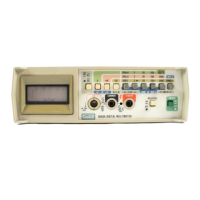THEORY OF OPERATION
CIRCUIT DESCRIPTION
negative, the buffer goes negative, the integrator goes
positive, and CM will go negative.
C9
will
continue to
charge until the end of the
100
millisecond Integrate
period. The microcomputer-controlled Integrate period
is
exactly the same length for every measurement
cycle,
regardless of the range and function selected.
3-12. After the microcomputer ends the Integrate
period, it prevents the integrate capacitor, C9, from
charging or discharging during a brief Hold period.
During the Hold period the microcomputer examines the
polarity of CM to determine the polarity
of
the unknown
input to the DMM.
3-13.
Since
CM
is
negative, the microcomputer initiates
the Read period with the
DE
(+R)
(de-integrate plus
reference) command (Part C of Figure
3-2),
CMOS
switch Ul8B connects the buffer input to COMMON,
and
CMOS
switches
U20A
and
U20B
connect
C7
in the
buffer feedback loop
so
that the integrator input
is
a
known level ( l
V)
of the opposite polarity from the input
signal. The integrate capacitor, C9, begins to discharge,
and the microcomputer starts
to
count from
00000. The
count accumulates until
C9
discharges to its initial level.
The instant
C9
reaches its initial level, the comparator
toggles
CM
positive,
stopping
the
count
in
the
microcomputer. The count in this case will
be
l
0,000.
This
count(with the
appropriate decimal point)
is
numerically
the same as the -1.0000V de input to the DMM.
3-14.
The third set
of
waveforms shows the timing that
would result from a positive full-scale input (in our
example, +I.9999V de). Note that for positive inputs,
CM
is
positive
so
the microcomputer uses the DE (-R)
(de-integrate minus reference) command during the
READ period. This connects
C7
so
that its polarity
is
reversed (as it must
be
to discharge
C9).
3-15. The bottom set of waveforms in Figure
3-3
shows
the timing that results from a positive overrange input to
the DMM.
If
the count in the microcomputer reaches
20,000
before CM toggles, the microcomputer detects this
as
an overrange condition and issues the overload
(OL)
command for 5 millisecond. The OL signal shorts
C9,
dumping the remaining charge. The following Autozero
period
is
doubled to
200
millisecond. The polarity of the
overrange input signal
is
retained and displayed.
NOTE
The display indicates an overload, between
20,000
and
20,055
counts,
but
the
a/
d
converter continues to integrate normally,
and
or
indicator does
not
appear.
3-16.
The
a/
d reference scheme
is
different if either the
kO
or
S
functions are selected. When the 2
mS, 2000,
or 2
kO range
is
selected, flying capacitor
C7
is
charged during
3-2
the Autozero period
by
the voltage drop across the
reference resistor instead of the
a/
d converter reference
voltage source. In
kn,
during the Integrate period, the
voltage drop across the unknown resistance
is
integrated.
During the Read period, the buffer input
is
connected to
COMMON,
and
C7
is
connected in the feedback loop of
the buffer. Therefore, the count accumulated in the
microcomputer during the Read period
is
proportional to
the ratio:
VRx
UNKNOWN V
V
nREF
-
REFERENCE V
or the ratio
of
voltage drops across the unknown and
reference resistors.
If
any
of
the other ranges
is
selected,
flying capacitor
C7
is
charged from the high side (VH) of
the reference resistor. During the Integrate period, the
voltage drop across the unknown resistance
is
integrated.
During the Read period, the low end of the reference
resistor (VL)
is
connected to the buffer input and
C7
is
connected in the buffer feedback loop. The count
is
again
proportional to the ratio:
VRx
UNKNOWN V
VH
-
VL
= REFERENCE
V
or the ratio
of
voltage drops across the unknown and
reference resistors.
3-17.
For
conductance
measurements,
the
microcomputer sends the
DE
(-R)
command' after the
Autozero period, and then the INT command. This
inverts the measurements
(S=l
/
0).
3-18. Microcomputer
3-19.
The microcomputer (Figure
3-4)
performs four
functions: control, measurement, calculation, and display
drive. The positions of the front panel switches determine
how the microcomputer performs each of these functions.
The microcomputer controls the gain and timing of the
a/
d converter and the gain
of
the ac buffers in accordance
with the measurement function and range selected. The
microcomputer measures the output
of
the
a/
d converter
by
accumulating counts. In any measurement function
the count accumulates linearly (count pulses evenly
spaced). The total count
is
numerically the same as the
unknown input to the
DMM
(a l.5001V
input results in
an accumulated count
of
15001).
If
the
dB
function
is
selected, the microcomputer calculates the
dB
reading
from the linear reading based on the reference impedance
(REF
Z)
selected. When the RELATIVE switch
is
set to
the ON
position, the microcomputer drives the display so
that
the
REL
annunciator
appears,
and
the
microcomputer stores the first measurement value as the
relative reference. This relative reference
is
algebraically
subtracted from subsequent measurements made in that
measurement function until the RELATIVE switch
is
set
to the
OFF
position.

